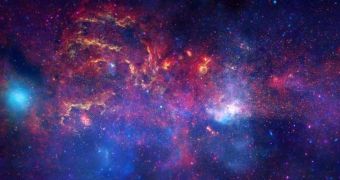By combining a number of scientific images from NASA's three Great Observatories – the Hubble and Spitzer Space Telescopes, and the Chandra X-ray Observatory –, scientists at the American space agency managed to create a stunning view of our galaxy, the Milky Way. The amazing photo, which was released yesterday, was meant as a celebration of the 400th anniversary since Galileo first turned his telescopes towards the skies, and set the basis for modern science. 2009 has been the International Year of Astronomy (IYA), and many countries around the world celebrated it in their own ways.
For this particular image, the three telescopes worked together flawlessly. Hubble snapped pictures of its designated locations using its near-infrared cameras, while Spitzer imaged the same structures using infrared wavelengths. Chandra photographed the galaxy using X-ray wavelengths. The resulting, multi-wavelength image is absolutely beautiful and unlike any other of the Milky Way ever obtained. It sheds an entirely new light on the galaxy, and may help further our understanding of the way our own, extended home functions, Space reports.
This is not by far the first image of the MW core ever to be taken. There are currently numerous questions about it that need answering, and the wealth of images that have been snapped over recent years are a testimony to astronomers' dedication for clearing the mystery. Astrophysicists, for instance, believe that a large black hole may be lurking at the core of the galaxy, but have yet to observe its accretion disk. The new image is one of the most detailed photos of the core that have ever been made available for scientific research.
Almost all structures that can be found in the Milky Way are shown in this image, ranging from very old, cool stars, to new, blue ones. Stellar nurseries – areas where new stars are being constantly formed – are also displayed in great detail, as is the massive cloud of dust that surrounds the core of the galaxy and shrouds it in secrecy. Though it has not been observed directly, the supermassive black hole at the center of the Milky Way is believed to be more than four million times the mass of our Sun.

 14 DAY TRIAL //
14 DAY TRIAL //